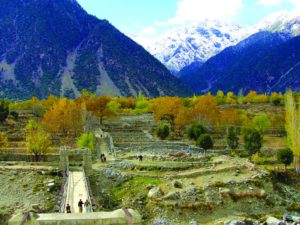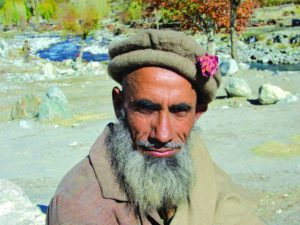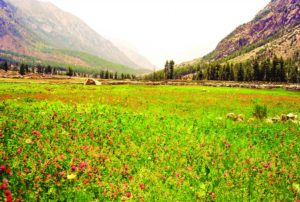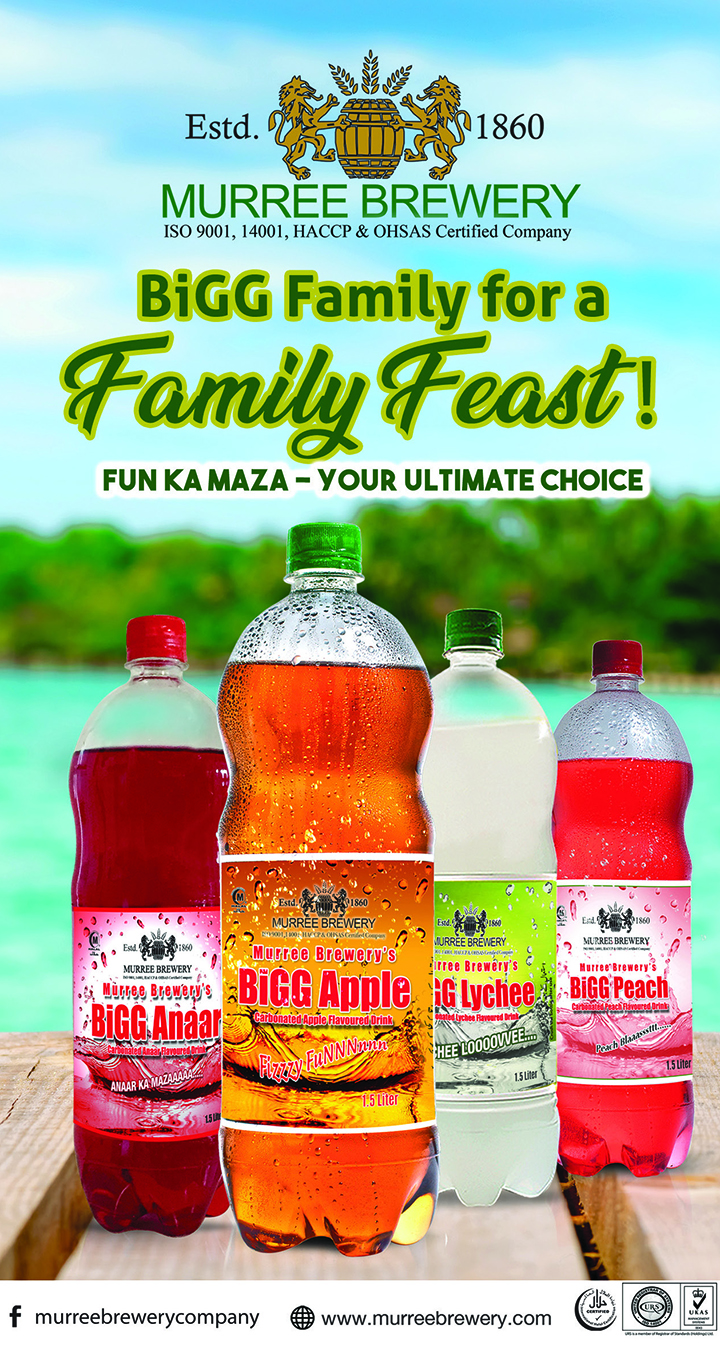
Flowers play an important role not only in the production of foods, spices, medicines and perfumes but also in myths and legends – in the fine and decorative arts, and literary works of prose and poetry. This is true across South Asian cultures.
Not much has been written on the importance of flowers in the cultures of certain communities in northern Pakistan. Likewise, the religious use of flowers is common in almost every major tradition of the world. They also play an important role in social life. Even as in urban areas of Pakistan one finds extensive flower markets, the usage of flowers is also common in the rural areas. And so they are used in festivities, parties and marriages ceremonies. Flowers are also showered on men of influence, whether they are religious or political leaders, on welcoming them to any occasion.

Like people in other valleys of Gilgit-Baltistan, Tangiri people in Diamer district also don traditional woollen caps (Khori in Tangiri and Khoi in Gilgiti Shina) which are made by local Tangiri artisans and are available in various colours.
Khori is the identity of Tangiri people, who sometimes stick a fresh flower or pine or jasmine leaves etc on the side or front of the cap. In other valleys of Gilgit-Baltistan people usually place a tuft of bird feather and pheasant plume in their caps. The tradition of the feather of a pheasant (lesh in Tangiri Shina) and a duck (deng Tangiri Shina) was once common in Tangir valley but it is no longer practised here. Instead, they keep fresh flowers (Pharu) in their caps now.
Tangiri people have been attracted to both colour and flowers since ancient times. In pre-Islamic Tangir, flowers were used in certain rituals to appease the deities and demons. There are still a few such customs which were once prevalent in other valleys of Gilgit-Baltistan and Indus Kohistan. In fact, during my several years of research on the culture of the Dardic communities in Darel and Tangir, I documented a few such customs.
The Tangir valley is famous for its natural beauty. The landscape of Tangir is full of flowers. In every nullah (side valley), wild flowers grow that add beauty to the landscape. The culture of the Tangiri people in this regard is very interesting. When one enters the Tangir valley, the first thing that one notices is the sight of people wearing fresh flowers in their caps. Decorating the caps with fresh wild flowers is the ancient custom in the Tangir valley for which they have many myths and stories to narrate.

Some locals explain this practice by saying that since people do not have other decorative things, they use fresh flowers which are the symbol of beauty and make them more elegant and stylish.
Flowers are not only used for decoration but also medicinal purposes in the Tangir and Darel valleys. Certain flowers, in this context, are used for abdominal diseases.
Though an attraction to the flowers is common across the valley’s populace, it is the shepherds who spend half of their lives in the nullahs, the side valleys, who seem to be their greatest admirers. While roaming with their flocks from one pasture (called Ayar in Tangiri Shina) to others, the shepherds become more close to nature. Even when they get too old to go to pastures and retire from herding, they continue to remember the landscape where they camped with their families and grazed their goats and sheep.
When the young shepherds are back from the pastures, the senior and retired shepherds discuss with them about the flowers, plants, trees, streams, lakes and everything that they saw themselves when they were young shepherds and moved with their herds in the pastures. Social memory for Tangiri shepherds serves as healing. The senior shepherds pluck the flowers from the village landscape and place them in their caps, recalling those days which they spent in the pastures in the side valleys and Satil meadow in Tangir.

A shepherd (piyalo) never misses an opportunity to meet a younger shepherd when he is back from the pastures. He discusses with him that landscape that he himself can no longer access. Families wait and pray for the safe return of the shepherds from the pastures when they bring butter back to the village.

Apart from self-decoration, flowers are also used in decorating the houses’ pillars, a custom that is also found in other valleys of Gilgit-Baltistan and in other Dardic communities in Indus Kohistan, Swat Kohistan and Dir Kohistan. This is a pre-Islamic custom which is still prevalent in some of these regions. In Tangir valley, this was done to ward off evil spirits and was a reminder to the demons to go back to their places. Tangiri people used incantations addressing the demons to come back only when certain flowers, which they hung on the pillars, were in bloom.

During the festival of Lesh Bash (celebration of gathering crops), the head of the household hits the pillars with an axe, where flowers are hanging down.
Although the festival of hanging flowers on the houses’ pillars is no more celebrated in Tangir, the tradition of keeping the flowers in the caps still continue. Some people link this tradition to their forefathers, and others believe that the tradition came to the valley from Indus Kohistan. But we can tell that in general this was prevalent among all the Dardic communities of Hindu Kush.

Most of the religious and secular architecture of Tangir is also decorated with floral designs, particularly the mosques and the wooden coffins. The lotus, which was once the most sacred flower of the Buddhist community, is still found in the architecture of the Tangir valley. It appears on wooden columns of houses, mosques, planks of wooden coffins and gharis (defensive towers). Likewise, sunflowers also decorate both the religious and secular architecture of Tangir valley.
The appreciation and love for flowers of the Tangiri people is shown not only in caps but also reflected in the names that they bestow upon on their children. Like men, women are also named after certain flowers, plants or trees. Some of the names of women include Sazin (name of a tree), Gaburi (a flower), Lalari (a flower), Jonji (a tree) and many others.
The writer is an anthropologist. He may be contacted at zulfi04@hotmail.com

Not much has been written on the importance of flowers in the cultures of certain communities in northern Pakistan. Likewise, the religious use of flowers is common in almost every major tradition of the world. They also play an important role in social life. Even as in urban areas of Pakistan one finds extensive flower markets, the usage of flowers is also common in the rural areas. And so they are used in festivities, parties and marriages ceremonies. Flowers are also showered on men of influence, whether they are religious or political leaders, on welcoming them to any occasion.

Like people in other valleys of Gilgit-Baltistan, Tangiri people in Diamer district also don traditional woollen caps (Khori in Tangiri and Khoi in Gilgiti Shina) which are made by local Tangiri artisans and are available in various colours.
Khori is the identity of Tangiri people, who sometimes stick a fresh flower or pine or jasmine leaves etc on the side or front of the cap. In other valleys of Gilgit-Baltistan people usually place a tuft of bird feather and pheasant plume in their caps. The tradition of the feather of a pheasant (lesh in Tangiri Shina) and a duck (deng Tangiri Shina) was once common in Tangir valley but it is no longer practised here. Instead, they keep fresh flowers (Pharu) in their caps now.
When the young shepherds are back from the pastures, the senior and retired shepherds discuss with them about the flowers, plants, trees, streams, lakes and everything that they saw themselves when they were young
Tangiri people have been attracted to both colour and flowers since ancient times. In pre-Islamic Tangir, flowers were used in certain rituals to appease the deities and demons. There are still a few such customs which were once prevalent in other valleys of Gilgit-Baltistan and Indus Kohistan. In fact, during my several years of research on the culture of the Dardic communities in Darel and Tangir, I documented a few such customs.
The Tangir valley is famous for its natural beauty. The landscape of Tangir is full of flowers. In every nullah (side valley), wild flowers grow that add beauty to the landscape. The culture of the Tangiri people in this regard is very interesting. When one enters the Tangir valley, the first thing that one notices is the sight of people wearing fresh flowers in their caps. Decorating the caps with fresh wild flowers is the ancient custom in the Tangir valley for which they have many myths and stories to narrate.

Some locals explain this practice by saying that since people do not have other decorative things, they use fresh flowers which are the symbol of beauty and make them more elegant and stylish.
Flowers are not only used for decoration but also medicinal purposes in the Tangir and Darel valleys. Certain flowers, in this context, are used for abdominal diseases.
Though an attraction to the flowers is common across the valley’s populace, it is the shepherds who spend half of their lives in the nullahs, the side valleys, who seem to be their greatest admirers. While roaming with their flocks from one pasture (called Ayar in Tangiri Shina) to others, the shepherds become more close to nature. Even when they get too old to go to pastures and retire from herding, they continue to remember the landscape where they camped with their families and grazed their goats and sheep.
When the young shepherds are back from the pastures, the senior and retired shepherds discuss with them about the flowers, plants, trees, streams, lakes and everything that they saw themselves when they were young shepherds and moved with their herds in the pastures. Social memory for Tangiri shepherds serves as healing. The senior shepherds pluck the flowers from the village landscape and place them in their caps, recalling those days which they spent in the pastures in the side valleys and Satil meadow in Tangir.

A shepherd (piyalo) never misses an opportunity to meet a younger shepherd when he is back from the pastures. He discusses with him that landscape that he himself can no longer access. Families wait and pray for the safe return of the shepherds from the pastures when they bring butter back to the village.

Apart from self-decoration, flowers are also used in decorating the houses’ pillars, a custom that is also found in other valleys of Gilgit-Baltistan and in other Dardic communities in Indus Kohistan, Swat Kohistan and Dir Kohistan. This is a pre-Islamic custom which is still prevalent in some of these regions. In Tangir valley, this was done to ward off evil spirits and was a reminder to the demons to go back to their places. Tangiri people used incantations addressing the demons to come back only when certain flowers, which they hung on the pillars, were in bloom.

During the festival of Lesh Bash (celebration of gathering crops), the head of the household hits the pillars with an axe, where flowers are hanging down.
Although the festival of hanging flowers on the houses’ pillars is no more celebrated in Tangir, the tradition of keeping the flowers in the caps still continue. Some people link this tradition to their forefathers, and others believe that the tradition came to the valley from Indus Kohistan. But we can tell that in general this was prevalent among all the Dardic communities of Hindu Kush.

Most of the religious and secular architecture of Tangir is also decorated with floral designs, particularly the mosques and the wooden coffins. The lotus, which was once the most sacred flower of the Buddhist community, is still found in the architecture of the Tangir valley. It appears on wooden columns of houses, mosques, planks of wooden coffins and gharis (defensive towers). Likewise, sunflowers also decorate both the religious and secular architecture of Tangir valley.
The appreciation and love for flowers of the Tangiri people is shown not only in caps but also reflected in the names that they bestow upon on their children. Like men, women are also named after certain flowers, plants or trees. Some of the names of women include Sazin (name of a tree), Gaburi (a flower), Lalari (a flower), Jonji (a tree) and many others.
The writer is an anthropologist. He may be contacted at zulfi04@hotmail.com


